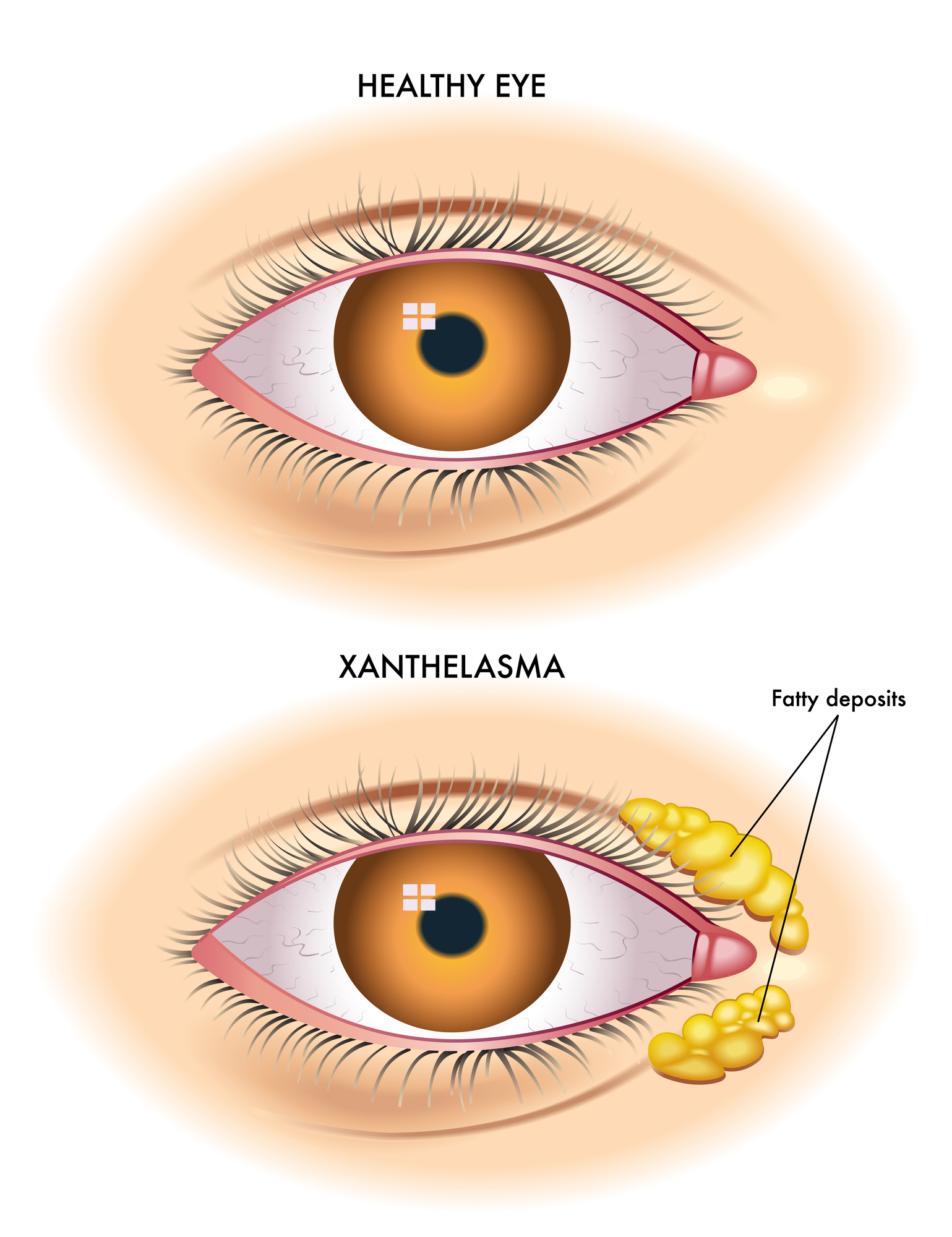Updated on April 30, 2025
Xanthelasma


Vision Center is funded by our readers. We may earn commissions if you purchase something via one of our links.
What is Xanthelasma?
Xanthelasmas (xanthelasma palpebrarum) are soft yellow patches that form on, near, or around the eyelids. They can appear flat or slightly elevated.1
Xanthelasmas are not dangerous or painful but might signal a serious underlying condition, such as diabetes, thyroid dysfunction, or hyperlipidemia (excess lipids in the blood).
If you develop xanthelasmas, consult a dermatologist or an oculoplastics surgeon.

Symptoms of Xanthelasma
Xanthelasma is a subtype of xanthoma, a condition characterized by the accumulation of cholesterol (lipids and fat) under the skin in different body parts. This might be due to:
- Metabolic disorders such as familial hypercholesterolemia or primary biliary cirrhosis (liver scarring)
- Genetic conditions that affect lipid production
- Excess consumption of fatty foods
- Lack of exercise
When cholesterol accumulates beneath the skin of the eye, it appears as yellow patches (xanthelasmas).
There are two types of cholesterol:2
1. Low-density lipids (LDL) or “bad” cholesterol. These make up the majority of cholesterol in the body and increase the risk of xanthelasma, stroke, and heart disease.
2. High-density lipids (HDL) or “good” cholesterol. These absorb the low-density lipids and take them to the liver for elimination. This lowers the risk of xanthelasma, stroke, and heart disease.
High levels of low-density lipids and low levels of high-density lipids increase the risk of xanthelasma development and may affect the heart and brain.3
What Causes Xanthelasma?
Natural fats like cholesterol can form growths, or patches, around the eyelids. These yellowish patches develop on the inner corner of the eyelids, which often affect the upper eyelids more than the lower. They are called xanthelasma.
What are the Risk Factors for Xanthelasma?
Xanthelasmas can affect anyone, but the following people are at a higher risk:
- Smokers
- Women4
- People between the ages of 30 to 50 years
- Asians or Mediterranean descent5
- Overweight people
- People with high blood pressure or diabetes
- People with abnormally high body fat content, including cholesterol
Having one or more of these traits does not guarantee the growth of xanthelasmas but increases the risk of developing this condition.
When to See a Doctor
Talk to your doctor if you notice yellowish deposits around your eyes. They’ll examine the xanthelasma to rule out any underlying conditions.
Diagnosis
A doctor can diagnose xanthelasma by evaluating the skin around the eyelids.
They may also order a blood test known as lipid profile or lipid panel to check triglyceride and cholesterol levels. The test can also show any health issues that might be causing your xanthelasma.
Treatment
Xanthelasmas never go away on their own. They might maintain their size or grow bigger over time. The good news is that they’re generally harmless.
Some people prefer to get rid of xanthelasmas for cosmetic reasons. The lipid deposits making the xanthelasmas can be removed via various procedures, including:
- Cryotherapy (extreme cold or freezing surgery). Liquid hydrogen, liquid nitrous oxide, or argon gas freeze the xanthelasma.
- Laser surgery. A laser resurfacing technique called fractional CO2 laser removes tissue layers forming the yellowish patches.6 It’s highly effective with short downtime.
- Traditional surgery. This method uses a special surgical blade to remove the xanthelasma and repair the skin.
- Electrodesiccation (extreme heat surgery). An electric needle passes a current through the tissue to burn off the abnormal growths.
- Chemical cauterization. It involves the use of topical treatments such as trichloroacetic acid (TCA) to treat skin discoloration, scarring, and wrinkles. TCA dissolves and clears the lipid component of the xanthelasma. It’s a type of chemical peel that induces chemical cauterization.
Although most of the methods above successfully remove xanthelasma, potential side effects include scarring and a change in skin color.
Xanthelasma can sometimes return after surgery, requiring repeated procedures. Most doctors recommend laser surgery to prevent scarring or tissue loss.
Xanthelasma removal is a cosmetic procedure and is therefore unlikely to be covered by insurance. On average, expect to pay about $300 to $500 per eyelid. Cost may increase depending on the complexity of the procedure, the facility, and your surgeon’s experience.
Before making a decision about xanthelasma removal, consult an experienced dermatologist or an oculoplastics surgeon.
Prevention
People who are genetically prone to high cholesterol might have difficulty preventing xanthelasma. To lower your cholesterol and risk of getting xanthelasma, you can:
- Quit smoking or don’t start
- Reduce alcohol intake
- Reduce your consumption of saturated fats
- Eat foods with “good” cholesterol, such as whole grains, fruits, vegetables, legumes, olive oil, and fatty fish
- Engage in moderate to vigorous exercise activities to burn calories
According to the Dietary Guidelines for Americans (DGA), saturated fat intake should account for 10% or less of your daily diet.
Outlook
Xanthelasma is a sign of cholesterol building up in your body and blood vessels. This can block blood vessels and cause a stroke or a heart attack.8
You can lower your risk of heart problems by visiting your doctor for regular checkups.
Your doctor can easily diagnose xanthelasma and investigate underlying conditions. They will also work with you to help you achieve your health or cosmetic goals.
Summary
Xanthelasmas are soft, yellow patches that form on, near, or around the eyelids due to the accumulation of lipid fats. They can appear flat or slightly elevated.
Xanthelasmas are not dangerous or painful, but they might signal a serious underlying condition.
Lipids are divided into low-density lipids (LDL) or “bad” cholesterol and high-density lipids (HDL) or “good” cholesterol. LDL accounts for most of the cholesterol in the body. High amounts of LDL increase the risk of xanthelasma.
Other risk factors include:
- Smoking
- Age
- Alcohol intake
- Consumption of saturated fats
- Obesity
- Lack of exercise
You can prevent xanthelasma development by living a healthy lifestyle, which includes a healthy diet and weight management strategies.
In this article
8 sources cited
Updated on April 30, 2025
Updated on April 30, 2025
About Our Contributors
Vincent Ayaga is a medical researcher and seasoned content writer with a bachelor's degree in Medical Microbiology. Specializing in disease investigation, prevention, and control, Vincent is dedicated to raising awareness about visual problems and the latest evidence-based solutions in ophthalmology. He strongly believes in the transformative power of ophthalmic education through research to inform and educate those seeking knowledge in eye health.
Dr. Melody Huang is an optometrist and freelance health writer with a passion for educating people about eye health. With her unique blend of clinical expertise and writing skills, Dr. Huang seeks to guide individuals towards healthier and happier lives. Her interests extend to Eastern medicine and integrative healthcare approaches. Outside of work, she enjoys exploring new skincare products, experimenting with food recipes, and spending time with her adopted cats.

